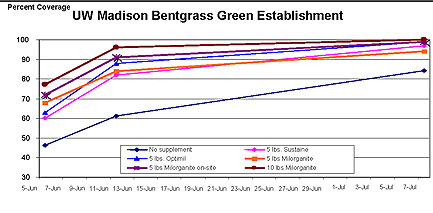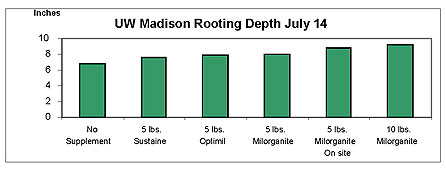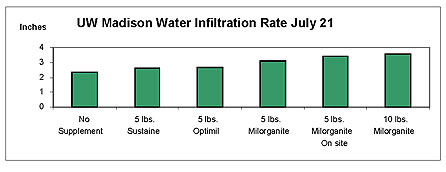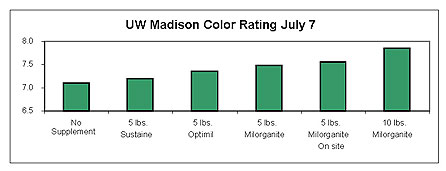Northern Greens

Rapid grow-in of golf greens is essential for quickly generating revenue at both newly constructed golf courses and those undergoing renovation. This is particularly important when using sand mixes with their inherent low fertility and nutrient holding capacity. Products that can help accomplish this while not adversely affecting the environment are especially favored.
Two research projects commissioned by Milorganite have established rates of Milorganite 6-2-0 fertilizer that are most effective in speeding greens establishment. Each study mixed Milorganite fertilizer with the sand/peat mix prior to greens construction. The University of Florida study also studied the composition of the leachate from these establishment plots. This was done to review the environmental impact of different fertilizer regimes and help determine the environmental impact of each regime.

Bentgrass Greens Establishment (USGA construction)
University of Wisconsin – Madison
An experimental putting green, constructed in compliance with USGA standards with original 80:20 sand:peat mix, was constructed for this study. The pH of this mix was 6.3. The root zone was then amended by adding specific organic materials to the original sand-peat root zone mix. Each organic supplement was added to the root zone mix at a rate of 5 lbs. per cubic yard, with one additional treatment of 10 lbs. of Milorganite per cubic yard. These sand, peat and organic supplements were mixed off-site, as recommended by the USGA, excepting one mixed on-site treatment established by tilling 5 lbs. Milorganite into the top six inches of the 80:20 sand-peat root zone mix.
All plots treated with supplements achieved more rapid grow-in than the control. The study also found that adding additional organic materials to the root zone mix increased root zone firmness and stability, improved water retention and water infiltration rates, enhanced color, increased rooting depth and reduced phosphorous deficiency symptoms.
Milorganite amended plots rated numerically higher or, at minimum, equal to the highest treatment, in all categories. Adding Milorganite to the original off-site mix or as an on-site supplement increased the coverage and performance of bentgrass golf greens.



In both fall and summer establishment, using Milorganite with and without supplements sped up turf coverage. Using Milorganite without supplements resulted in faster coverage compared to supplements only or the non-treated control. In many cases this fill-in rate was not significantly different than from using supplements (without the additional cost of these supplements).
Another benefit of not using supplements was shown in reviewing the amount of phosphorus leached from the plots. For the summer plots, the amount of phosphorus collected in the lysimeters was significantly higher for plots treated with supplements vs. those untreated. Also, note that, if supplements are used, the amount of phosphorus collected decreased with higher rates of Milorganite being used. This is consistent with other research (not a part of this work) indicating that Milorganite does not tend to leach phosphorus.

